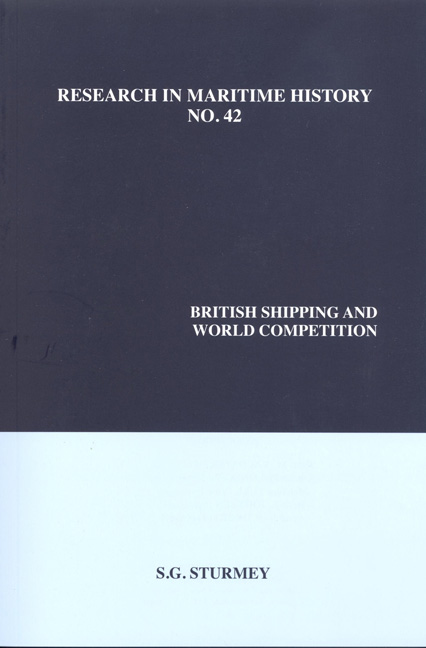Book contents
- Frontmatter
- Table of Contents
- Series Editor's Foreword
- About the Author
- Preface
- Figures and Tables
- Chapter 1 The Problem Defined
- Chapter 2 High Water: The Pre-1914 Period
- Chapter 3 War and Reconstruction
- Chapter 4 The Troubled Years: The Interwar Period
- Chapter 5 Nationalism in Shipping in the Interwar Years
- Chapter 6 The Birth of the Liberty
- Chapter 7 The Prosperous Age: The Postwar Period
- Chapter 8 Enemies of Competition in the Postwar Years
- Chapter 9 Flags of Convenience
- Chapter 10 Economics of Shipping Enterprises
- Chapter 11 Shipowning and Resource Allocation
- Chapter 12 Labour Relations and Labour Costs (by Basil Mogridge)
- Chapter 13 The Conference System
- Chapter 14 The Structure of the British Industry
- Chapter 15 The Question Answered
- Epilogue The Future
- Appendix The Contribution of British Shipping to the Balance of Payments
- Bibliography
- Index
Preface
- Frontmatter
- Table of Contents
- Series Editor's Foreword
- About the Author
- Preface
- Figures and Tables
- Chapter 1 The Problem Defined
- Chapter 2 High Water: The Pre-1914 Period
- Chapter 3 War and Reconstruction
- Chapter 4 The Troubled Years: The Interwar Period
- Chapter 5 Nationalism in Shipping in the Interwar Years
- Chapter 6 The Birth of the Liberty
- Chapter 7 The Prosperous Age: The Postwar Period
- Chapter 8 Enemies of Competition in the Postwar Years
- Chapter 9 Flags of Convenience
- Chapter 10 Economics of Shipping Enterprises
- Chapter 11 Shipowning and Resource Allocation
- Chapter 12 Labour Relations and Labour Costs (by Basil Mogridge)
- Chapter 13 The Conference System
- Chapter 14 The Structure of the British Industry
- Chapter 15 The Question Answered
- Epilogue The Future
- Appendix The Contribution of British Shipping to the Balance of Payments
- Bibliography
- Index
Summary
The main object of this book is set out in the first sentence of chapter one. That difficulties would be met in realizing this objective is obvious, and it is not surprising that, with an industry so secretive as shipping, realization has been incomplete. In particular, the absence of positive information bearing on the problems considered has often meant that direct assessment has been impossible, and a comparative study has had to be made.
During the period covered by this book the industry published three statements of its problems, the first in 1917, the second in 1939 and the third in 1960. Despite this documentation, a further study was necessary for several reasons. First, the 1917 and 1939 reports are not available publicly. Second, the reports are descriptive rather than analytic in content. Third, the reports group important and unimportant factors without discrimination, and there are a number of notable omissions. Fourth, there is no hint of self-examination by the industry in the reports. Fifth, the recommendations for action in the reports are recommendations to people outside the industry, not plans for self-help; this follows naturally from the absence of self-criticism.
In the text it will often be found that, in addition to explaining the past, I have offered suggestions for the future and tried, generally, to suggest courses of action by which the industry could secure its position for that future. I hope that those shipowners who feel aggrieved at the critical nature of the work will take the time seriously to consider the many positive proposals which are scattered through the ensuing pages.
In writing this book I have incurred very many debts to people and organizations in America, Britain, Ireland, Italy, The Netherlands, New Zealand and Norway. To all who helped me so generously I am deeply grateful. I owe a considerable debt to the Trustees of the Houblon-Norman Fund for providing the financial support which enabled the work to be undertaken. My greatest debt of all is to Basil Mogridge who for two years laboured patiently collecting material. He proved a hard-working and highly intelligent colleague, a source of inspiration and enthusiasm and a delightful companion.
- Type
- Chapter
- Information
- British Shipping and World Competition , pp. xiii - xivPublisher: Liverpool University PressPrint publication year: 2009

